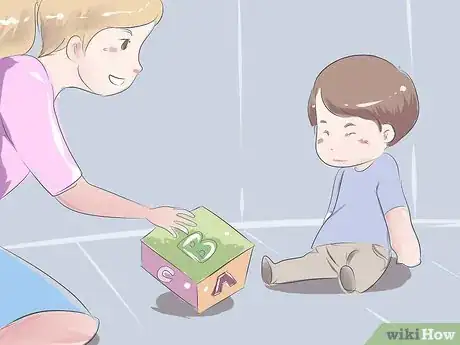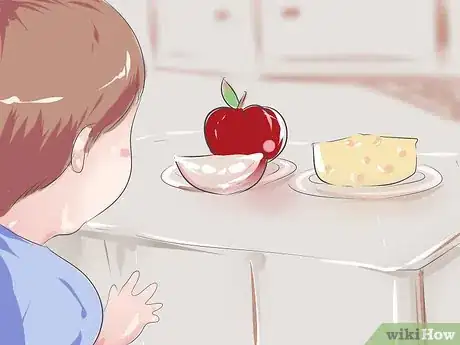This article was co-authored by Sylvia Rath. Sylvia Rath is a Parenting Specialist and the Director of Little Village Nursery School in Los Angeles, California. With over 30 years of experience, Sylvia guides parents through the preschool years and beyond by teaching respectful communication and positive discipline methods. Sylvia holds a BA in Psychology and Early Child Development from Antioch University. Before working at Little Village Nursery School, she taught preschool for eight years.
This article has been viewed 135,854 times.
Toddlers are typically energetic and easily distracted, and they get fidgety, cranky, and uncomfortable when they are required to sit still and behave themselves. This is totally normal, and you shouldn’t worry if it seems that your toddler has something along the lines of a one-minute attention span. Still, there are times when you’ll need to get your toddler to sit still. Start with Step 1 for some helpful tips!
Steps
Developing the Ability to Sit Still
-
1Practice sitting still. Sitting still does not come naturally to most toddlers, but you can practice the skill at home. To start, have your toddler sit in your lap for one full minute. Challenge your child to sit as still as possible. Gradually lengthen the time until your child can sit still for longer stretches.
- Do not entertain your toddler too much during these practice sessions. Playing, tickling, singing, and the like defeat the purpose: you’re trying to get your child to tolerate peaceful stretches of time without entertainment.
- As your toddler improves at this exercise, you can switch from your lap to a chair. Sit next to your child and continue to challenge him to sit still.
-
2Read aloud to your child. Reading aloud engages your toddler in a quiet, attentive activity, building his or her ability to focus and sit peacefully. Teach your toddler to pay attention to details: ask questions and point out interesting things in the pictures.Advertisement
-
3Encourage artistic activities. Make sure your toddler has access to paper, crayons, pencils, and/or paint. These activities are also engaging and encourage a longer attention span. Challenge your child to finish a picture before moving on to something else.
- At first, it may help to participate in these activities alongside your child. Having your attention may encourage your child to focus on an artistic endeavor for a longer period of time. As he or she learns to be more focused and attentive, you can begin to sit back and watch.
-
4Play games that require quiet attention. Try to get your toddler to play with blocks, puzzles, and other games that don’t involve physical activity. These games help toddlers develop memory skills, fine motor coordination, and the ability to sit still.
-
5Build quiet moments into your family’s routines. Choose some regular times to sit quietly together as a family, perhaps at the beginning of a meal or at some designated time for quiet reading. If your toddler sees his or her parents and siblings modeling appropriate activity, he or she will catch on more quickly.[1]
-
6Use mealtimes as practice. Young children should learn to sit quietly at the table during meals. Make sure your child understands that running around during meals is unacceptable; he or she needs to sit still and finish eating before getting up to play. Because mealtimes occur so regularly, they offer a great opportunity for practicing your toddler’s skills.[2]
- Set a good example during mealtimes. When you sit down to dinner with your family, do not get up to answer the phone or see what’s on television.
- Consider letting your child bring a doll or teddy bear to the table as a dining companion. Point out that the doll or teddy does not jump around at the table.
-
7Reward your child’s efforts. When your toddler does a good job sitting still or paying attention, offer lots of specific praise. Consider offering a small treat – a piece of chocolate, a trip to the park – for particularly good behavior.
Helping Your Child Sit Still
-
1Prepare your child. If you are going to be in a situation where your toddler will have to sit still, start preparing early. Let your toddler know what the situation will be and what kind of behavior you expect. Typical situations include:
- Restaurant meals. Even more than meals eaten at home, meals eaten at restaurants demand good behavior. Don’t expect miracles – choose family-friendly restaurants – but let your toddler know that he or she needs to sit still and behave.
- Haircuts. If your toddler wiggles, fidgets, and jumps around, it will be very difficult to manage a good haircut. Explain this to your child in advance, and suggest that he or she sit as still as possible and watch the haircut in the mirror.
- Medical examinations. Children do need to sit still during medical exams, especially for blood tests and other lab work. Prepare your child in advance. During the exam, try to occupy your child as best you can. Distract by pointing out colorful paintings or drawings, and use your imagination: a drop of blood can be a ladybug or raspberry juice.
- Church, concerts, and theater performances. Again, prepare your child in advance. Understand, though, that your child may not be able to sit still for something as lengthy as a church service or a concert. Plan to take quick breaks, taking your child outside to burn off some energy.[3]
-
2Make sure your child’s basic needs are met. You cannot expect a hungry, thirsty, exhausted, or otherwise uncomfortable toddler to sit still and behave; it will not happen. Don’t attempt any event that requires sitting still without feeding your toddler and making sure his or her other needs are met.
-
3Distract your child. When your child needs to sit still, whether it’s during a meal or at a doctor’s appointment, it helps to offer a distraction. Have your child focus on a painting on the wall, his or her image in the mirror, a silly song or story – anything that works. If necessary, bring favorite toys, picture books, and snacks.[4]
- In rare cases, you may want to break out a cartoon or electronic device. This can work when you really need your child to stay still – as at the doctor’s office or barber shop. But don’t use this strategy very often; you’ll only teach your child to zone out in front of a screen.
-
4Dress your child to suit the activity. When your toddler is running around, you can dress him or her in play clothes and sneakers. When you are doing something that will require “best behavior,” change clothing to reflect your expectations. Teach your child to recognize the difference.
- Do not, however, dress your child in anything too stiff, uncomfortable, or confining. This could backfire, making your child more fidgety than ever.
-
5Be an authority figure. Children have the right to play and enjoy a carefree childhood, but you still have to keep things under control. Remember that you set the rules, and you need to expect your toddler to respect them.
- At the same time, keep your expectations in check. Don’t punish a toddler for failing to sit quietly through an hour-long church service; that’s not fair. But do consider mild, age-appropriate punishments for bad behavior.
-
6Give your child choices. Although you are the authority, you can still give your child some control. Let your toddler make some decisions. Will he or she sit in your lap or in a chair? Does he or she want apple slices or cheese cubes? Permitting your toddler to make some choices will allow a sense of independence and control.
-
7Praise good behavior. Let your toddler know that you are proud when he or she sits quietly and behaves well.
Community Q&A
-
QuestionHow old can a toddler start to sit?
 PurplecakecarolineCommunity AnswerA toddler can start to sit down when they are about 1 or 2 years old.
PurplecakecarolineCommunity AnswerA toddler can start to sit down when they are about 1 or 2 years old. -
QuestionI have a 3-year-old boy who behaves at home but refuses to sit and throws tantrums and is hard to control in school. What should I do?
 Community AnswerAsk his teachers to keep a 'communication diary'. The teacher will write down how he behaves in school each day and send the diary home with him. Disicipline or rewards can be presented at home depending on how he's behaved. You can communicate back to the teachers what steps you're taking at home so that everyone is on the same page. You may also want to explore the cause(s) of this behavior a little: Is he lonely at school? Is he homesick or scared? Are children being mean to him?
Community AnswerAsk his teachers to keep a 'communication diary'. The teacher will write down how he behaves in school each day and send the diary home with him. Disicipline or rewards can be presented at home depending on how he's behaved. You can communicate back to the teachers what steps you're taking at home so that everyone is on the same page. You may also want to explore the cause(s) of this behavior a little: Is he lonely at school? Is he homesick or scared? Are children being mean to him? -
QuestionHow to study without kids around
 AlleycatroxCommunity AnswerSet up an area that you know for sure that kids won't be at. If that isn't an option, try to set up an activity for them outside to do or in another room. If none of those work, have someone that you can trust and rely on can have them go to their house to do yard work or something more fun so that it will give you some study time.
AlleycatroxCommunity AnswerSet up an area that you know for sure that kids won't be at. If that isn't an option, try to set up an activity for them outside to do or in another room. If none of those work, have someone that you can trust and rely on can have them go to their house to do yard work or something more fun so that it will give you some study time.
References
- ↑ https://www.betterhealth.vic.gov.au/health/HealthyLiving/toddlers-and-mealtime-manners
- ↑ https://www.parents.com/toddlers-preschoolers/feeding/problems/6-ways-to-encourage-toddlers-to-actually-sit-still-and-eat/
- ↑ https://www.whattoexpect.com/toddler/ask-heidi/sitting-still.aspx
- ↑ https://www.whattoexpect.com/toddler/ask-heidi/sitting-still.aspx
- http://www.ahaparenting.com/ask-the-doctor-1/getting-toddlers-to-sit-at-the-table-for-dinner
- http://www.sheknows.com/parenting/articles/805281/tips-and-tricks-for-surviving-toddler-haircuts
- http://www.whattoexpect.com/toddler/ask-heidi/sitting-still.aspx
About This Article
Teaching your toddler to sit still doesn’t have to be difficult, especially if you practice regularly and combine it with fun activities. Try getting your toddler to sit still on your lap for 1 minute, then gradually lengthen the time. That way, they can get used to it without having to sit still for long. You can give your child a treat after they follow your instructions, like a piece of chocolate or a trip to the park. If your toddler refuses to sit, try offering them a choice so they feel in control. For example, if they won’t sit on your lap, you might ask them whether they want to sit in the chair or on your lap. While your toddler sits, read a book aloud to them to attract their attention. You could also give them a puzzle book or coloring pens and paper so they have something to play with that requires them to stay still. For tips on how to get a child to sit still during a meal, keep reading!










































































